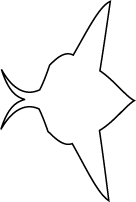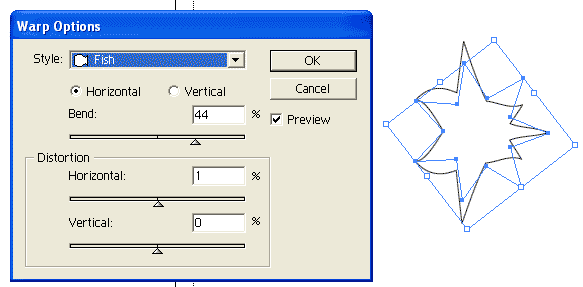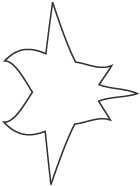 |
Introduction Site Map Email: jja@nac.net |

"I don't know. It is Odin's disk and it has only one side."
— J. L. Borges, The Disk.


Monday, July 19th, 2004
 As I work in
Illustrator, sometimes I arrive at unintended images. I don't
remember what process led to this object; it's likely just a random
doodle with symmetry applied. I called it 'Ray,' though it could just
as easily be seen as a flying turnip.
Designing convincing alien critters will be a major part of my project,
and I seem to have some facility for doing so. I will post some
examples this evening.
As I work in
Illustrator, sometimes I arrive at unintended images. I don't
remember what process led to this object; it's likely just a random
doodle with symmetry applied. I called it 'Ray,' though it could just
as easily be seen as a flying turnip.
Designing convincing alien critters will be a major part of my project,
and I seem to have some facility for doing so. I will post some
examples this evening.Update:
I'm going to expand on the above entry a bit and discuss the drawing of alien life forms at another time.
After I examined the file, I remembered how I made it. It's a result of what's called a warp effect, a new feature of Illustrator 10. The base figure was a 7 pointed star, which is trivial to generate in Illustrator. The image below shows the warp fisheye filter in the act of generating something similar to the above figure; the original star is highlighted in blue:

I believe I used a combination of effects, and not just fisheye, to get the above Ray, though I don't remember what other effects I used.
I tried another effect called fish on the same star:

And got this:
 While these things
are interesting, I don't intend at present to use such effects in my
project as a basis for drawing alien life..
While these things
are interesting, I don't intend at present to use such effects in my
project as a basis for drawing alien life..One reason is that it's just too easy - the kind of thing that may be good to know if you need something for a tight deadline, but not the level of quality I would be willing to accept on a regular basis. But at bottom, it's a question of the balance between control and incidental effects.
All media have incidental effects - behavior that is not directed by the artist save in a general sense. For instance, when you paint a watercolor, you control the paint color and general shape of the brushstroke. However, the paper will absorb the paint, capillary action drawing pigment through fibrous channels, and producing detail that is dependent on the material and not your actions. You're powerless to tell the paint not to flow this way, though you may apply control at a different level by reducing the water content of the paint, choosing different art paper, and so on.
I regard incidental effects such as watercolor bleeds, brushstrokes impressed in blobs of paint, grain induced by the fabric pattern of the canvas, etc. in traditional media to be analogous to pixelization, blur effects, printer screening, and other aspects of production in electronic media. Incidental effects at this level is a tool of the trade and indispensable, as one would surely go crazy trying to place every pixel by hand or turning each grain of sand just so.
At a higher level, things get blurry. Art does get produced at a larger scale by incidental effects. (The famous example is that of Protogenes of Rhodes, who was trying to paint the foam on the mouth of a panting dog without success; in frustration, he hurled his sponge at the canvas and it caused the exact effect he wanted.) Such effects are also employed deliberately and constructively. But I feel that, in the case of the above effect, too much of what should be handled by artistic interaction (brain and brush) is being left to an algorithm. It would be better if I understood the effect deeply enough to make it generate what I already had in my head, instead of altering what's in my head to match what I have produced accidentally and without comprehension. The latter way, I think, madness lies. Or at least loss of discipline.
If you think I'm right or wrong, feel free to drop me an email at the address in the left sidebar. If I get any impassioned responses, I'll respond to them next Thursday. Otherwise, I shall strive to put up some of my xenography and commentary on the same. Until!



pageatatime.com is hosted by net access corporation - www.nac.net